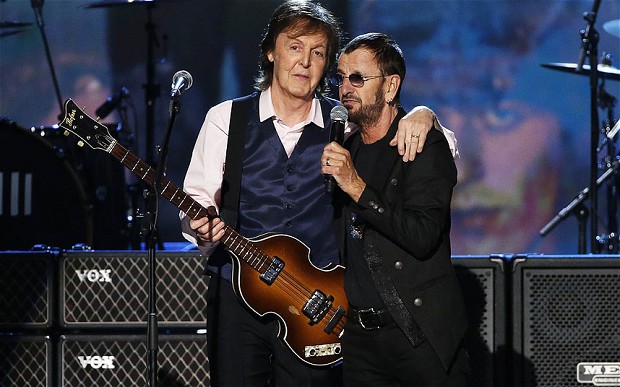 For all its hype and pitfalls, “The Night That Changed America: A Grammy Salute to the Beatles” on Sunday had its moments — the ones connected to the band itself.
For all its hype and pitfalls, “The Night That Changed America: A Grammy Salute to the Beatles” on Sunday had its moments — the ones connected to the band itself.
The two surviving members are old road pros, even at 71 and 73 (!), and can make a thrilling live show out of old memories. But when Paul McCartney did the transition at the end of “Sgt. Pepper’s Lonely Heart’s Club Band,” calling for Billy Shears, and Ringo Starr comes out to sing “With a Little Help from My Friends,” it’s the kind of transition that hadn’t been done since the record came out, and I’m pretty sure had never been done live.
It was the kind of moment that should have opened the Grammys a couple of weeks ago (and the whole rest of that show would have struggled to equal).
Otherwise, it was more of a Grammys salute, where other artists sing the tunes of the honoree. When they transitioned from clips of the original Beatles performances into live music from invited acts, it was always a disappointment. No I don’t want to hear Maroon 5 sing “I Saw Her Standing There,” Sexiest Man Alive or Not.
When they play the rooftop performance of the Beatles’ “Don’t Let Me Down,” the transition to John Mayer and Keith Urban is in fact a letdown.
But it was great to hear Stevie Wonder do his take of “We Can Work It Out,” which he took to No. 15 in 1971.
Throughout, a backing band featuring Peter Frampton, Don Was, Steve Lukather and Kenny Aronoff were solid; the guitar interplay of Joe Walsh and gary Clark Jr. on “While My Guitar Gently Weeps” was fine, but it made me think of how much better Prince’s take of it was at the Rock and Roll Hall of Fame.
George Harrison got plenty of props, with performances of that, “Here Comes the Sun” and “Something.” But Dhani Harrison should have been used more than in one song. And why wasn’t Sean Lennon used at all?
The greatest possible moment would have been the sons of Harrison and Lennon joining their dads’ bandmates for a fourpiece rendition of anything from the early days, but that never happened.
I think of the Beatles as having three distinct periods (four if you include the solo years that followed), the middle period was bristling with creativity and innovation, the latter part in experimentation and searching, but the first part was all brash joy and exuberance. That’s what made their appearance on “The Ed Sullivan Show” 50 years ago the cultural landmark it was, and I think the whole of the special should have focused on 1964. Playing “Hey Jude” and “Let It Be” was just as out of place as playing “Live and Let Die” would have been (and to have Alicia Keys and John Legend sing “Let It Be” while Paul is sitting right there seemed wrong in any case). Still, if Dave Grohl is able to make a modern hit out of the little-known “Hey Bulldog” more power to him.
I liked all the detail about the early days — the screaming girls and women all tracked down and interviewed; the show designers and producers recalling that day, and even Paul and Ringo strolling through the Ed Sullivan theater and talking about that moment with its current occupant David Letterman, like former homeowners returning to a house decades later for a tour with the current resident.
Not that much came out of those interviews. It’s not that the two couldn’t remember much; it’s that they honestly couldn’t perceive the U.S. cultural impact of what they were doing from the eye of the hurricane.
The one thing I learned from the special was not in the biographical bits narrated by Eric Idle as if in a Rutles spoof, it was when Ringo said he used to sing “Boys” when he was in Rory & the Hurricanes, before he joined the Beatles.
And having him play that, as if it were 64 all over again, was the second greatest high point of the night.